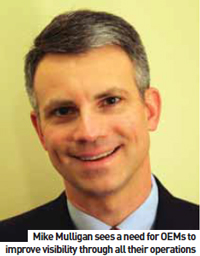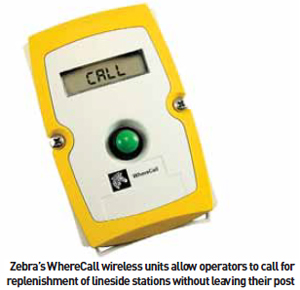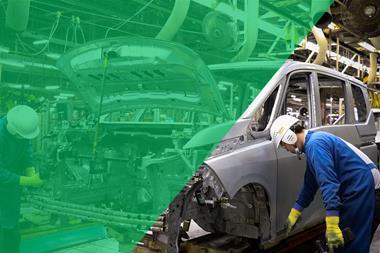
As demand returns to many regions, OEMs require more visibility throughout the supply and manufacturing chains
Timely and accurate delivery of materials and components to production lines is at the heart of any efficient automotive manufacturing facility and is a particularly relevant subject as vehicle output increases in various new markets, especially in the BRIC countries.
These locations have many of the elements required to produce vehicles in massive volumes; domestic demand, low- to medium-cost labour forces, available land, natural resources and in some cases, cheap and abundant power supplies. But with these new frontiers, simply due to the sheer size of countries such as China and India, come long supply chains, variable supplier quality standards and often an electronic communications architecture that is still in its infancy.
 How to harness these great opportunities for low-cost manufacturing while maintaining quality and deliverability? One of the answers is ‘execution systems’; management and communication protocols that husband material and resource planning and mesh it with efficient manufacturing throughput.
How to harness these great opportunities for low-cost manufacturing while maintaining quality and deliverability? One of the answers is ‘execution systems’; management and communication protocols that husband material and resource planning and mesh it with efficient manufacturing throughput.
AMS talked to Michael Mulligan, Director, Automotive Solutions at Zebra Technologies. Zebra is an international company with around 2,500 employees in more than 50 locations worldwide. The company has implemented its asset management and execution systems, at more than 250 customer manufacturing installations around the globe.
We started by asking Mulligan to outline Zebra’s offerings in automotive; firstly about the software solutions that it can offer the automotive industry?
MM: Zebra offers multiple solutions for the automotive industry, including asset visibility, in-bound yard management, vehicle tracking and material replenishment.
Our lineside material replenishment solution, Material Flow, is a manufacturing execution system that brings replenishment, messaging and asset tracking from the front office to the shop floor. The system directs the movement of materials via the people that need to know what, where and when - the material handlers themselves. With a Mobile Ruggedized Terminal (MRT) mounted on their equipment or a handheld by their side, the material handlers get real-time prioritized material requests that allow them to get materials to lineside just in time. The result of this is higher productivity with less need for ‘tribal knowledge’.
Productivity goes up, lineside inventory goes down.
AMS: And the hardware that you offer, is this bespoke and how much do you outsource on behalf of your customers?
MM: We use standard equipment and tailor its deployment to the individual needs of each customer. All of the infrastructure required for our call systems (wireless buttons and location sensors) is our own equipment, built upon industry standards. We also partner with companies such as LXE and Motorola for their MRTs and handheld devices, respectively.
AMS: Many of your customers must have legacy systems in place. How easy is it to ‘mesh’ your systems with existing architecture within a facility?
MM: In many cases our customers were using replenishment systems that relied on radio traffic, or simply patrolling around looking for empty containers to replenish. In these cases there is nothing to mesh with. In cases where there is a legacy system in place, we can easily import data from those systems. We have also integrated the Material Flow software with ERP systems.
AMS: How do you approach meshing your systems with the ‘culture’ of your customers’ existing systems?
MM: From a software perspective, we keep our system simple, with a web-based application running on industrystandard operating systems and browsers. This eliminates client installs and upgrades on shopfloor machines.
Although our system is designed with multiple platforms in mind, our existing customer base has chosen to run Windows-based servers with Microsoft SQL database technology.
AMS: You deal with the logistics end of the business, but also go right up to the production line. How do you manage the relationships, with the OEM/supplier customer, the logistics service provider, the different suppliers delivering and consolidating components and modules - the customer is senior of course but how is the other hierarchy worked out?
MM: While our customers include systems suppliers, the OEMs (stamping, assembly, powertrain) and logistics providers, they come to us for similar reasons, largely to help improve supply chain visibility. We’ve been successful at working across the supply chain, within specific networks of companies, to improve their operational performance by working as partners.


As OEMs take a more holistic view of their business and redefine competitiveness as the performance of their entire supply chain, our solutions align and support this perspective. For example, we offer a systems supplier the ability to see the same type of calls for replenishment that their customer’s material handlers see in real time. Through Material Flow’s Supplier Portal feature, the supplier can see how demand levels are fluctuating against their build schedule and ship accordingly, avoiding premium freight charges or line stoppages.
AMS: How much training and assistance do you offer your customers and who pays for this?
MM: We offer on-site training for all users of our systems at the time of install or upgrade. This cost is included in the initial deployment quotation. Likewise we offer refresher training, either on-site or at any of our training facilities at a reasonable cost to the customer.
AMS: On a typical OEM contract, how many Zebra people would be at the customer’s facility during ramp-up and how many would stay on to oversee smooth running, etc?
MM: Because of the way we designed our system, we only need one to three people onsite during the ramp-up period and another on-line remotely checking configuration. We usually have one person on-site for go-live with two to four resources available by phone to make sure everything goes as planned.
AMS: What is your view of the traditional ERP/MRP approach and tools?
MM: ERP/MRP systems are quite necessary and complimentary to the solutions we provide down at the execution and control levels. More often, our customers are asking us to integrate our solutions with ERP and WMS, as they remain the systems of record. By sharing information between systems we can create a more realistic picture of what’s happening, thereby improving our customers’ performance.
 AMS: And how have you seen these areas change over the last few years?
AMS: And how have you seen these areas change over the last few years?
MM: The biggest change has been the requirement to share information between systems.
AMS: What are some of the special challenges in emerging markets?
MM: The two biggest challenges we’ve seen are employing lean manufacturing concepts and the trade-off in automation versus labour. Most customers we’ve worked with in emerging markets have been slower to adopt lean manufacturing concepts, and in many cases were operating at levels below their potential.
We’ve had the opportunity to come in and understand their environment and needs. Through education and mutual respect, we defined what was possible and then developed careful, controlled changes that could be implemented and measured rather quickly. Through this type of interactive programme, we developed confidence and trust in the approach and our customers.
The other shift has been in the area of deploying automation in an environment where labour is a more prevalent answer than in Europe or North America. While our value proposition remains the same, bringing visibility to entire supply chain networks, we act flexibly and deploy in a slightly different fashion, which takes advantage of the labour strengths of the region. Having a broad technology portfolio puts us in a unique and favourable position.
AMS: And to what extent do you rely on local personnel and native tongue speakers?
MM: Without local personnel and native-language speakers, we wouldn’t be successful. As a global company with over 2,500 employees worldwide, we live and work side-by-side with our customers and partners.
AMS: The wireless factory is the dream for many production managers. How does Zebra fit into this and is wireless always desirable?
MM: The wireless factory has many advantages, including the significant reduction of costs and flexibility associated with initial installation and subsequent line changeover.
Each of our locating and messaging systems employ wireless technology. Because we have multiple types of technology in our portfolio, we can recommend the appropriate solution for each customer’s needs, without the costs of bespoke equipment.
Our solutions have been running wirelessly in some plants for over ten years and these customers can attest to the reliability of the signals and durability of the equipment.
AMS: What is Zebra’s involvement in service parts/spare parts, handling and shipping, and receiving? MM: We get involved in service/spare parts if there are assets of value that require tracking.
We have an in-bound yard management solution that is built specifically for the needs of the automotive industry. Our solution is flexibly designed to run either in softwareonly mode or with full location, depending upon the complexity of the yard and the customer’s requirements. On the opposite side of the plant, we have a vehicle tracking solution for managing the quality test and repair process. The system performs two main functions: locate vehicles in real-time within the facility (indoor and outdoor) and direct the movement of vehicles through the test and repair process so that the right vehicle is queued up to the right test or work bay at the right time. Using the system, our customers have increased vehicle throughput while reducing employee numbers, dramatically reducing the number of vehicles shipped with a quality hold, which is especially important during a new model launch. Some of our customers have chosen to integrate this system with their quality systems to achieve even better outcomes. Our solutions typically have a six-to-twelve month payback period and a ROI that meets or exceeds the customer’s targets.
AMS: On lineside equipment, what systems do you favour and in what applications would you use/recommend for activities such as kitting, modular assembly, group assembly, with delivery to the line?
MM: Through our material flow software, we facilitate the replenishment of parts and systems to lineside. We support materials in any form, whether they’re bulk, individual, kitted, etc. Further, we support multiple types of triggers, including, but not limited to, our call buttons, barcode scans and broadcasts.
AMS: How involved do you get in your customer’s choice of handling equipment? Would you recommend AGVs, etc., where appropriate, for example?
MM: While we don’t specify or recommend material handling equipment, companies who adopt our material replenishment solution have found great success in equipping them with mobile rugged terminals, barcode scanners and location tags. The MRTs run our software, which directs the movement of materials via the driver. Bar code or passive scanners are useful for error-proofing an inventory pick and location tags mounted to the material handling equipment is useful for locating the unit itself, but also for associating its location with that of the goods being transported.
AMS: What are Zebra doing to help get fork trucks out of the plants of tomorrow?
MM: Philosophically, this is a decision left to our customers. However, by replenishing material just-in-time, we can help reduce unnecessary fork truck traffic, as well as reduce the amount of inventory required, thereby improving visibility and safety. When the lineside inventory can safely be reduced without risk of shortage and line stoppage, the large amounts of material that generally require a fork truck to deliver are greatly reduced or even eliminated.
AMS: Do you get involved in the ergonomics of lineside tasks and how can you make processes easier and more comfortable for line workers? Essentially, how can you help carmakers improve lineside delivery?
MM: Zebra WhereCall buttons help workers stay in their work cells focused on assembly, not replenishment. They remove the need for line workers to either leave their workstation to flag down a patrolling material handler or to make a radio call for more parts.
Our call buttons are wireless, enabling them to be mounted in appropriate locations that optimize productivity and ergonomics.



































